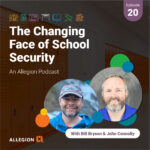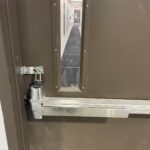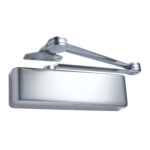Back in March, I posted a code change proposal regarding classroom security that will be included in the 2018 International Building Code (IBC). This change will affect new buildings, additions, and renovations once a jurisdiction has adopted the 2018 edition of the IBC. Granted, it will be several years before this code is widely used, but the hope is that jurisdictions will adopt the new code language regarding classroom security prior to adoption of the entire code, rather than creating different requirements for each state.
Since the IBC doesn’t typically apply to existing buildings, it was very important to incorporate similar language into the International Fire Code (IFC), for a consistent approach across new and existing schools. A proposal was submitted by the Fire Code Action Committee, and the change was “approved as submitted” at the Committee Action Hearings in April. Until the July 22nd deadline, public comments could be made regarding any of the proposed changes to the IBC – these comments will be discussed at the next set of hearings.
The public comments were posted last week, and because there were no comments on the classroom security proposal there will be no discussion of this change at the final hearings. That means that this change will be incorporated into the 2018 IFC:
1031.2.2 Locking arrangements in educational occupancies. In Group E occupancies, Group B educational occupancies and Group I-4 child day care occupancies, egress doors from classrooms, offices and other occupied rooms shall be permitted to be provided with locking arrangements designed to keep intruders from entering the room where all of the following conditions are met:
1. The door shall be capable of being unlocked from outside the room with a key or other approved means.
2. The door shall be openable from within the room in accordance with Section 1010.1.9.
3. Modifications shall not be made to existing listed panic hardware, fire door hardware or door closers.
4. Modifications to fire door assemblies shall be in accordance with NFPA 80.
Similar to the IBC requirements, the key points in this code change are:
- This language applies to K-12 schools, colleges and universities, and I-4 child care facilities.
- The locking requirements apply to classrooms and also to offices and other occupied rooms.
- If the rooms are lockable, they must be able to be unlocked from the outside.
- Locks are not required by code, but if locks are used, the doors have to meet the requirements for egress – one operation to unlatch, no key/tool/special knowledge/effort, no tight grasping/pinching/twisting, etc.
- Listed panic hardware, fire door hardware, and door closers may not be modified.
- If the doors are fire doors, modifications must meet the requirements of NFPA 80.
Many states have adopted the IFC as their state fire code (often with state modifications). The classroom security change that will be included in the 2018 IFC is consistent with the IBC, and early adoption of this language would go a long way toward maintaining life safety and creating a uniform set of requirements across the United States. If the AHJs in your state are considering this issue, please let me know.
For more information about classroom security, visit the School Security page on this site.
You need to login or register to bookmark/favorite this content.





Best news in a long time.
Seriously.
What a win, and way to stay true to the basics! Have to say there were many “solutions” being conjured up by all kinds of companies, many posing more questions rather than answers. Kudos, Lori!
Nailed it!
This is great to see. People are not creating their versions of intruder devices with any other thought than an easy way to stop an attack. It’s our responsibility as hardware and security professionals to help them understand the unintended consequences of other solutions.
Our fight is exacerbated by the fact that many of the devices conjured up these days are both inexpensive and very easy to deploy. That doesn’t make them good, or safe, but to all the folks screaming for some solution, they seem attractive.
Safe and functional products, be they mechanical locking or electronic based can do what they need, but we need to help them understand why the price delta is worth it.
Keep up all you do!